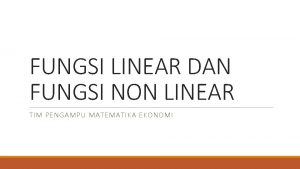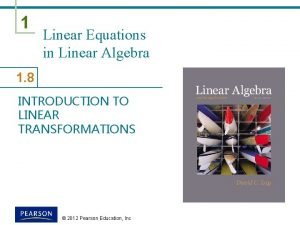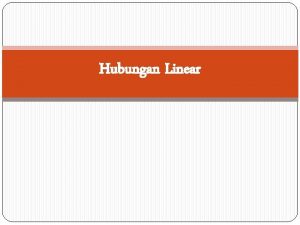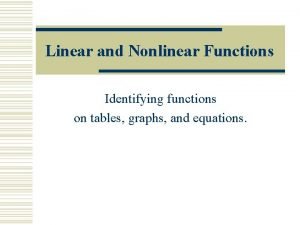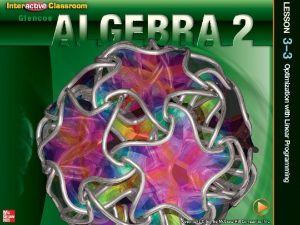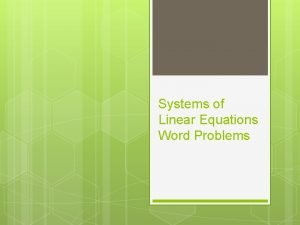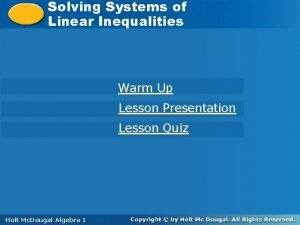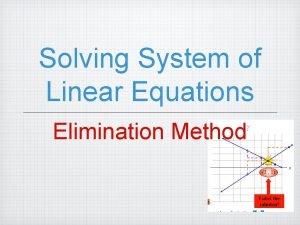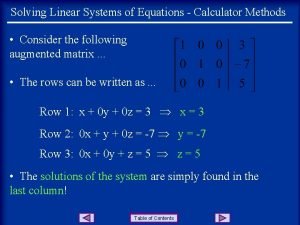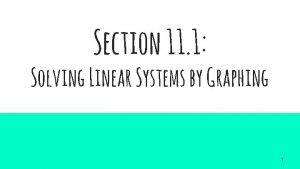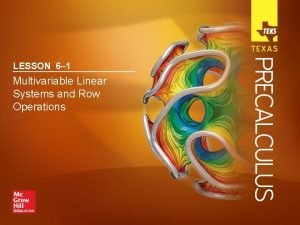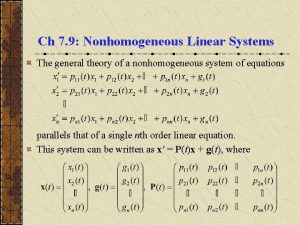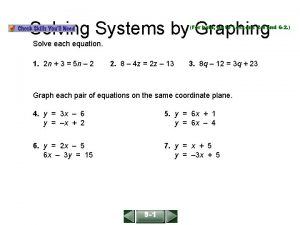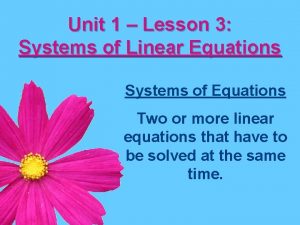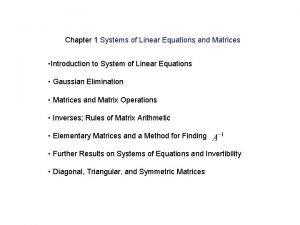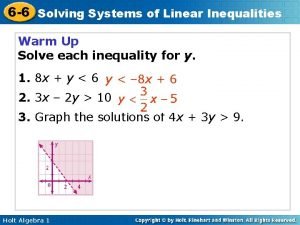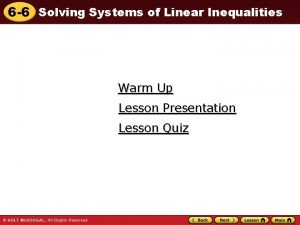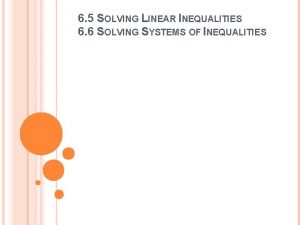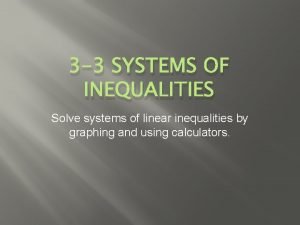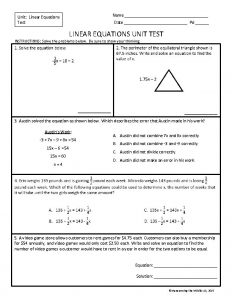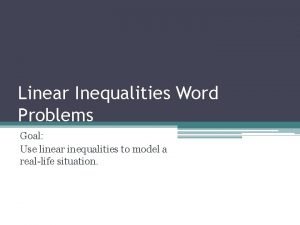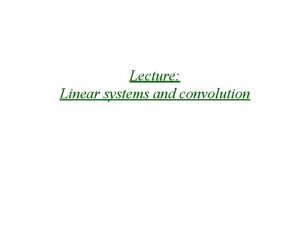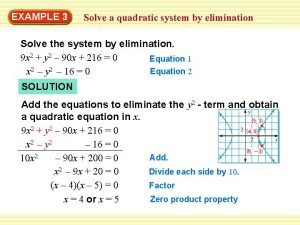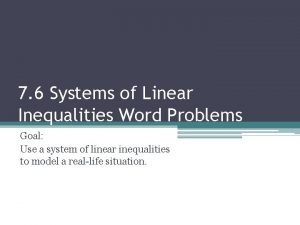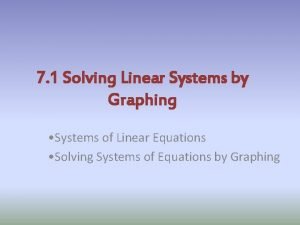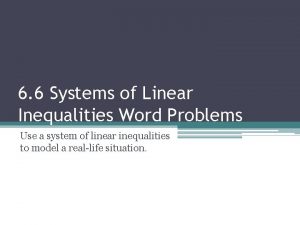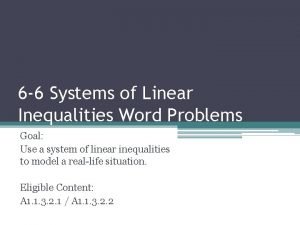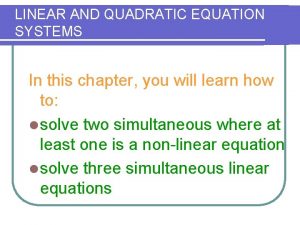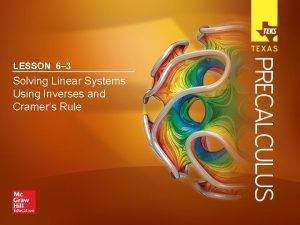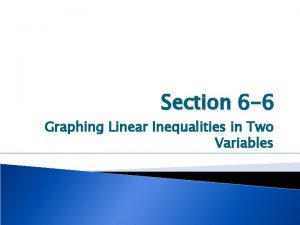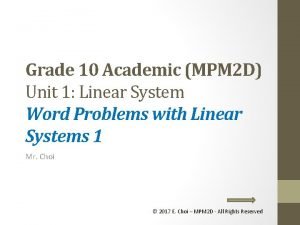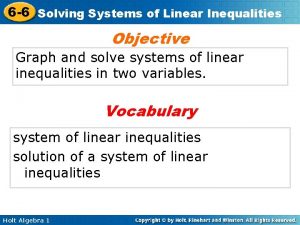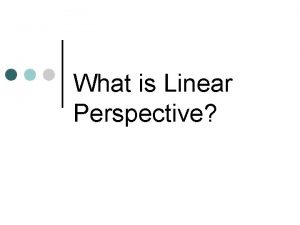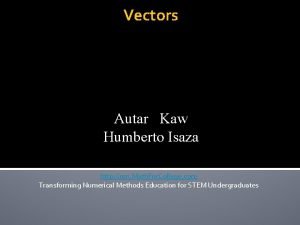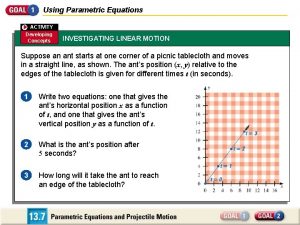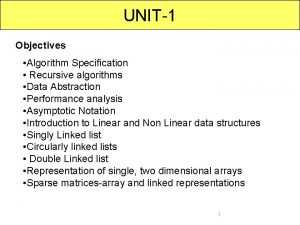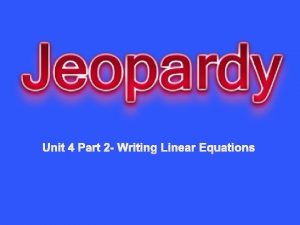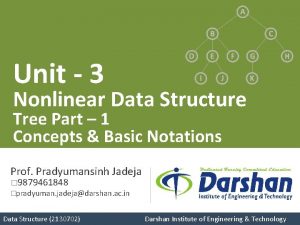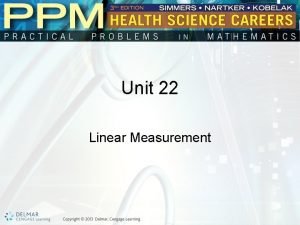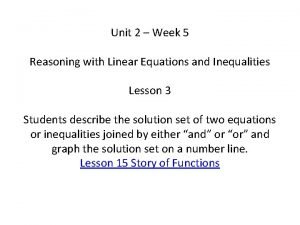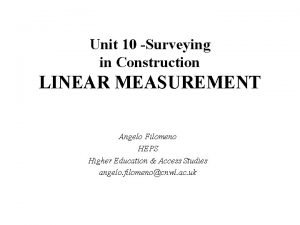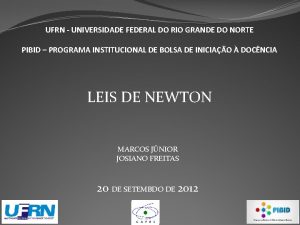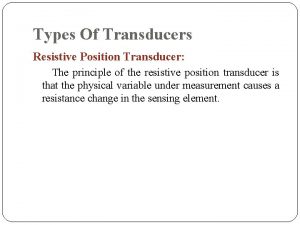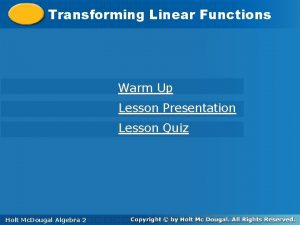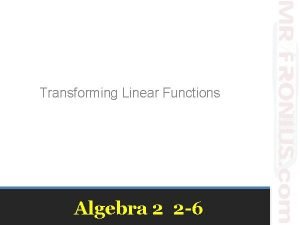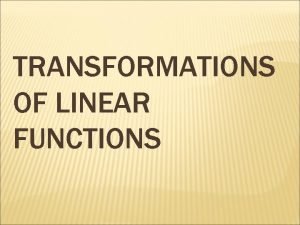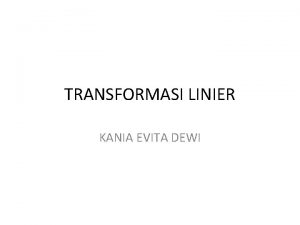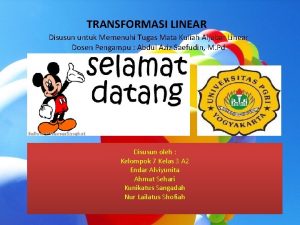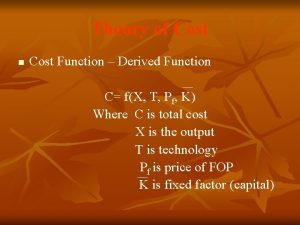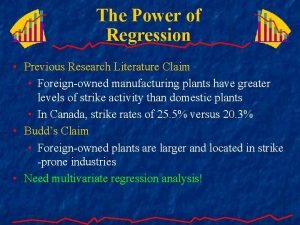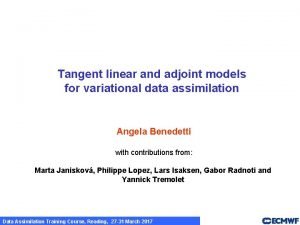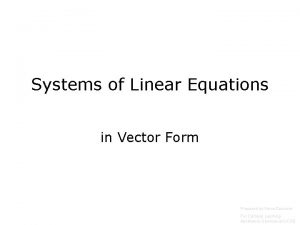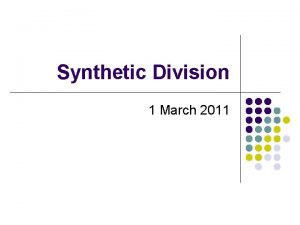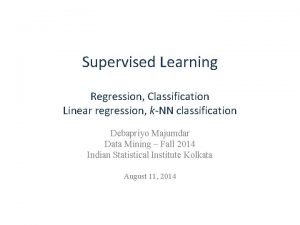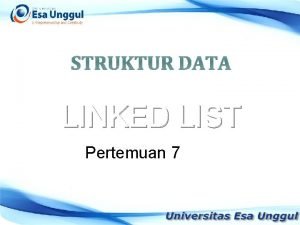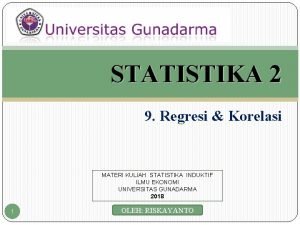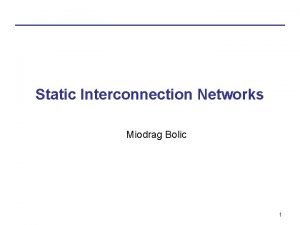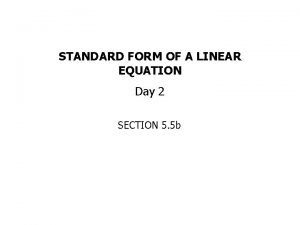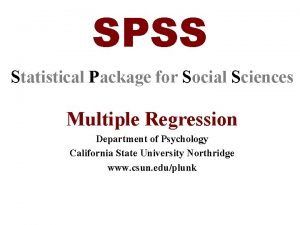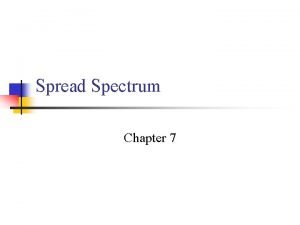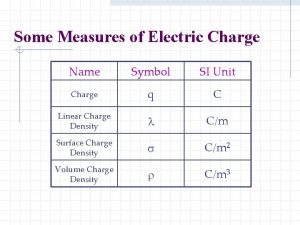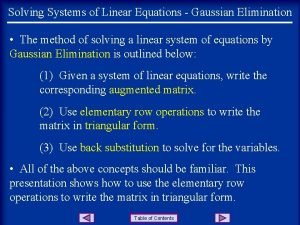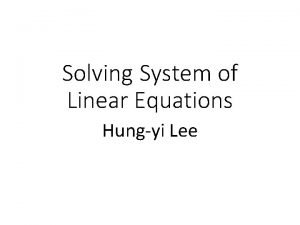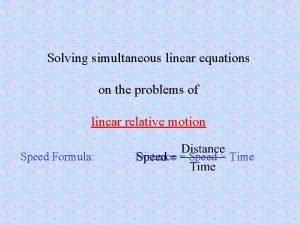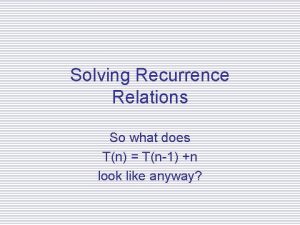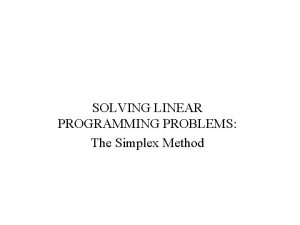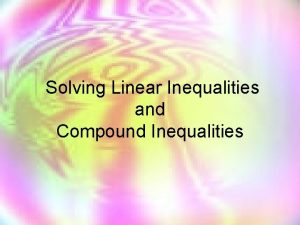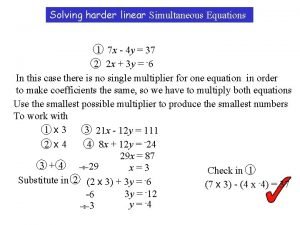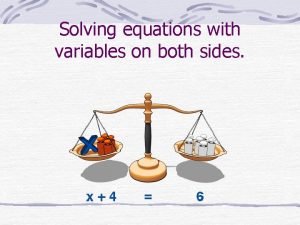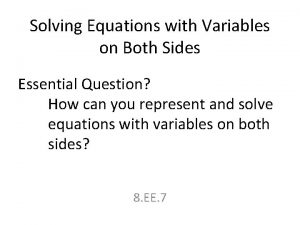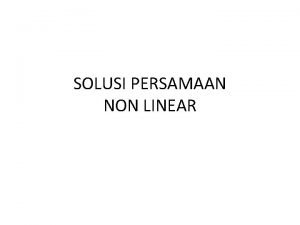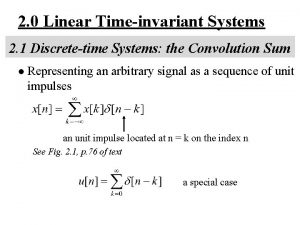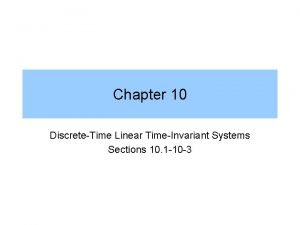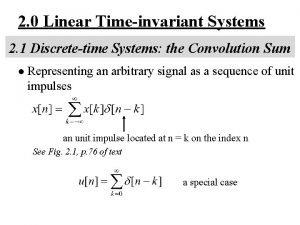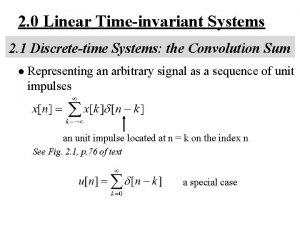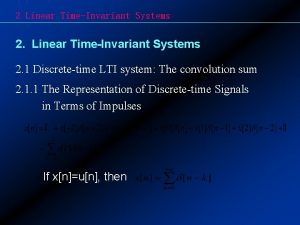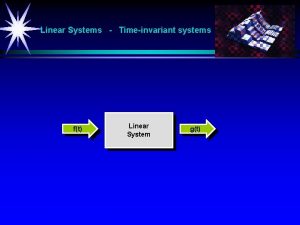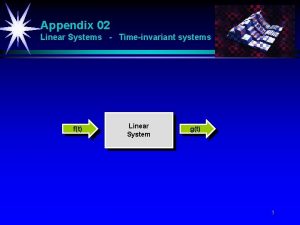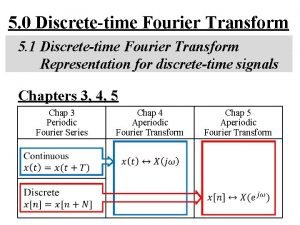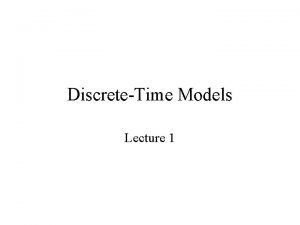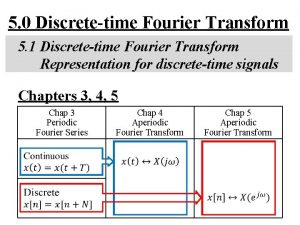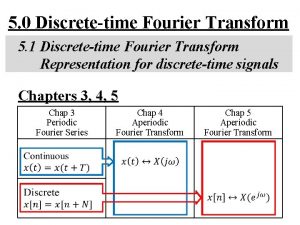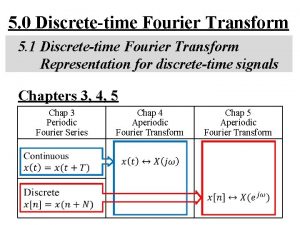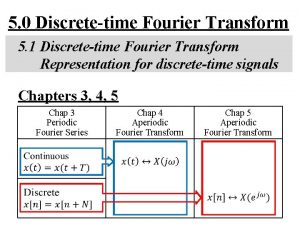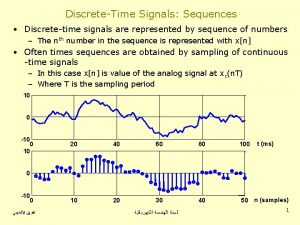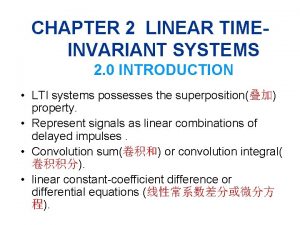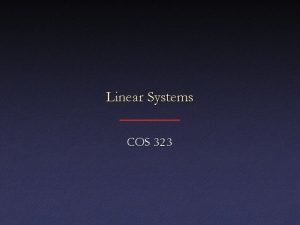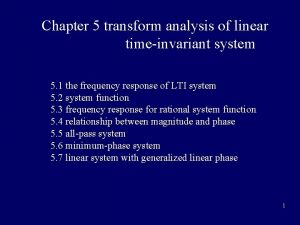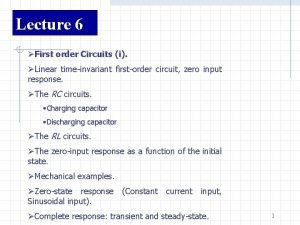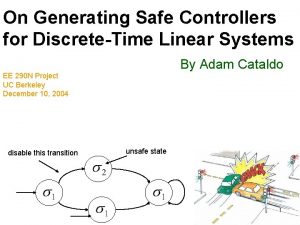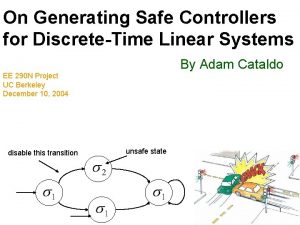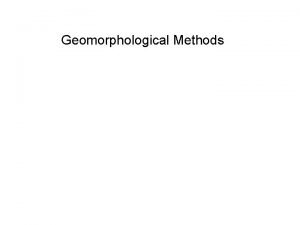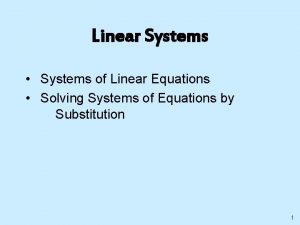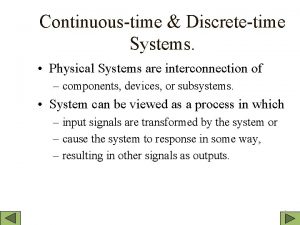2 0 Linear Timeinvariant Systems 2 1 Discretetime



































![System Characterization l Matrix Representation of Convolution Sum example: x[n]=… 0, 0, x 1, System Characterization l Matrix Representation of Convolution Sum example: x[n]=… 0, 0, x 1,](https://slidetodoc.com/presentation_image_h/731a7cb86e4a668a1e8a368776e8da3e/image-36.jpg)

























![l Causality – causal if y[n] dose not depend on x[k] for k > l Causality – causal if y[n] dose not depend on x[k] for k >](https://slidetodoc.com/presentation_image_h/731a7cb86e4a668a1e8a368776e8da3e/image-62.jpg)





![l Stability stable if bounded input gives bounded output |x[n]| < B, all n l Stability stable if bounded input gives bounded output |x[n]| < B, all n](https://slidetodoc.com/presentation_image_h/731a7cb86e4a668a1e8a368776e8da3e/image-68.jpg)







![Block Diagram Representation l Elementary Operations x 2[n] x 2(t) x 1[n ] x Block Diagram Representation l Elementary Operations x 2[n] x 2(t) x 1[n ] x](https://slidetodoc.com/presentation_image_h/731a7cb86e4a668a1e8a368776e8da3e/image-76.jpg)
![Block Diagram Representation l Elementary Operations x[n] x(t) D x[n-1] Block Diagram Representation l Elementary Operations x[n] x(t) D x[n-1]](https://slidetodoc.com/presentation_image_h/731a7cb86e4a668a1e8a368776e8da3e/image-77.jpg)
![Block Diagram Representation l An Example x[n] b y[n] D -a y[n-1] – Feedback, Block Diagram Representation l An Example x[n] b y[n] D -a y[n-1] – Feedback,](https://slidetodoc.com/presentation_image_h/731a7cb86e4a668a1e8a368776e8da3e/image-78.jpg)







































- Slides: 117

2. 0 Linear Time-invariant Systems 2. 1 Discrete-time Systems: the Convolution Sum l Representing an arbitrary signal as a sequence of unit impulses an unit impulse located at n = k on the index n See Fig. 2. 1, p. 76 of text a special case


Vector Space Representation of Discretetime Signals (P. 47 of 1. 0) l n-dim


Vector Space Interpretation

Vector Space (P. 30 of 1. 0) 3 -dim Vector Space

N-dim Vector Space (P. 31 of 1. 0) (合成) (分析 )

Vector Space Interpretation

l Representing an arbitrary signal as a sequence of unit impulses (合成) an unit impulse located at n = k on the index n l Sifting property of the unit impulse: looked at on the index k, δ[n-k] is nonzero only at k = n, which “sifts” the value x[n] out of the function x[k]. (分析)

l Defining the output for an unit impulse input as the Unit Impulse Response x[n]= [n] y[n]=h[n]: unit impulse response S 0 n

l By Linearity (Superposition Property) – The output for an arbitrary input signal is the superposition of a series of “shifted, scaled unit impulse response” x[k] [n-k] x[k] Convolution Sum See Fig 2. 3, p. 80 of text h[n-k]

Input/Output Relation in Every Dimension


l A Different Way to visualize the convolution sum – looked at on the index k input signal Contribution to the output signal at time n reflected-over version of h[k] located at k = n – on the dummy index k, h[k] is reflected over and shifted to k=n, weighted by x[k] and summed to produce an output sample y[n] at time n See Figs 2. 5, 2. 6, 2. 7, pp. 83 -85 of text


Fig. 2. 6



l A linear time-invariant system is completely characterized by its unit impulse response


Vector Space Concept l Definition of Inner-product – Example – Simple Definition


Inner Product magnitude similarity

Linearity in Inner Product Commutative, Non-degeneracy

Vector Space Concept l Definition of Inner-product – Physical Properties: magnitude, similarity – For the vector space of signals defined in (N 1, N 2) – Inner-product Space – (N 1, N 2) extended to (-∞, ∞)

Vector Space Concept l Magnitude/Similarity

Vector Space Concept l Orthonormal bases – orthogonal – orthonormal basis any vector (signal) in the vector space can be expanded by the set of orthonormal signals (合成)

System Characterization l Vector Space – Orthonormal bases time-shifted unit impulses, dim = ∞ – A signal expanded by this set of orthonormal basis (合成)

System Characterization l A Different View of the Sifting Property – 3 -dim vector space – Sifting property (分析)

System Characterization l Transformation of Vectors – A System is a Transformation which maps one vector x[n] to another vector y[n] (linear, time-invariant) H[ ]

l Defining the output for an unit impulse input as the Unit Impulse Response (P. 10 of 2. 0) x[n]= [n] y[n]=h[n]: unit impulse response S 0 n

l Rotation as a vector transformation y (1, 0, 0 ) (a, b, c) x Rotation as a vector transformation (1, 0, 0) → (0. 9, 0. 3) (0, 1, 0) → (0. 3, 0. 9, 0. 3) (0, 0, 1) → (0. 3, 0. 9) Rotation plus vector scaling (1, 0, 0, 0, ⋯) → (0. 9, 0. 3, 0. 2, ⋯) (0, 1, 0, 0, ⋯) → ( 0, 0. 9, 0. 3, 0. 2, ⋯) (0, 0, 1, 0, ⋯) → ( 0, 0, 0. 9, 0. 3, 02, ⋯)

Splitting a single basis vector into a few more basis vectors a (a, b, c) b c (1, 0, 0 ) – transforming a single basis vector enough to describe the transformation of any vectors

System Characterization l Transformation of Vectors – unit impulse response is the transformation of δ[n]. A basis vector is transformed to a set of other bases – superposition property for convolution sum

System Characterization l Linear, Time-invariant Transformation of vectors can be expressed by a matrix x y Convolution Sum
![System Characterization l Matrix Representation of Convolution Sum example xn 0 0 x 1 System Characterization l Matrix Representation of Convolution Sum example: x[n]=… 0, 0, x 1,](https://slidetodoc.com/presentation_image_h/731a7cb86e4a668a1e8a368776e8da3e/image-36.jpg)
System Characterization l Matrix Representation of Convolution Sum example: x[n]=… 0, 0, x 1, x 2, 0, 0, … h[n]=… 0, 0, h 1, h 2, 0, 0, … y[n]=… 0, 0, y 1, y 2, y 3, y 4, 0, 0, …

Matrix Representation 01 2 0 1 2 0 1 2 1 2 3 0 1 2 2 3 4

System Characterization l Matrix Representation of Convolution Sum – each component of the input vector is transformed to a set of other components of the output vector, and all these are superpositioned (superposition property) – each component of the output vector is contributed respectively by the transformed component of each input vector component (reflected, shifted, weighted sum)

2. 3 Continuous-time System : the Convolution Integral l Representing an arbitrary signal as an integral of impulses See Fig 2. 12 , p. 91 of text an impulse located at t = τ whose value is x(τ) (合成) a special case




Vector Space Interpretation (P. 8 of 2. 0)

Vector Space Representation discrete-time: continuous-

Continuous-time Vector Space

Unit Step 1 0 0 t t – running integral 0 t

l Representing an arbitrary signal as an integral of impulses – Sifting Property : (分析) Looked at on the index τ, δ(t-τ) located at τ = t shifts the value x(t) out of the function x(τ) See Fig 2. 14 , p. 94 of text


l Defining the output for an unit impulse input as the unit impulse response S 0 t Unit Impulse Response 0 t

l By Linearity (Superposition Property) – The output for an arbitrary input signal is the superposition of a series of “shifted, scaled unit impulse response” Convolution Integral

l Defining the output for an unit impulse input as the Unit Impulse Response (P. 10 of 2. 0) x[n]= [n] y[n]=h[n]: unit impulse response S 0 n

l By Linearity (Superposition Property) (P. 11 of 2. 0) – The output for an arbitrary input signal is the superposition of a series of “shifted, scaled unit impulse response” x[k] [n-k] x[k] Convolution Sum See Fig 2. 3, p. 80 of text h[n-k]

Input/Output Relation in Every Dimension (P. 12 of 2. 0)

Input/Output Relation in Every Dimension 0 0 0

l A Different Way to visualize the convolution integral – Look on the index τ input signal output signal at time t reflected-over version of h(t)located at =t – On the dummy index τ, h(t) is reflected over and shifted to τ = t, weighted by x(t) and integrated to produce the output value at time t, y(t) see Figs. 2. 19, 2. 20, 2. 21, pp. 100 -101 of text l A linear time-invariant system is completely characterized by its unit impulse response

0



2. 4 Properties of Linear Time-invariant Systems l Commutative Property – the role of input signal and unit impulse response is interchangeable, giving the same output signal – In evaluating the convolution sum or integral, the input signal can be reflected over and weighted by the unit impulse response

l Distributive Property additive (linear) property

l Associative Property – Cascade of two systems gives an unit impulse response which is the convolution of the unit impulse responses of the two individual systems – The behavior of a cascade of two systems is independent of the order in which the two systems are cascaded
![l Causality causal if yn dose not depend on xk for k l Causality – causal if y[n] dose not depend on x[k] for k >](https://slidetodoc.com/presentation_image_h/731a7cb86e4a668a1e8a368776e8da3e/image-62.jpg)
l Causality – causal if y[n] dose not depend on x[k] for k > n – Causal iff h[n]=0, n < 0

l Causality – continuous-time – Causal iff h(t)=0, t<0

Causality (P. 56 of 1. 0)

Causality & Memory (for future) non-causal memory (for past) non-causal

l Memoryless / with Memory – A linear, time-invariant, causal system is memoryless only if if k=1 further, they are identity systems – sifting property, i. e. , convolution sum (or integral) with an unit impulse function gives the original signal

l Invertibility / Inverse system
![l Stability stable if bounded input gives bounded output xn B all n l Stability stable if bounded input gives bounded output |x[n]| < B, all n](https://slidetodoc.com/presentation_image_h/731a7cb86e4a668a1e8a368776e8da3e/image-68.jpg)
l Stability stable if bounded input gives bounded output |x[n]| < B, all n – Stable iff the impulse response is absolutely summable, or absolutely integrable, the necessary condition can be proved

l Unit step response output for an unit step function input Running sum First difference similarly Running integral First derivative

2. 5 Systems Described by Differential/Difference Equations Continuous-time l Differential Equation Specification for Input/Output Relationships – derived by physical phenomena and relationships – very often auxiliary conditions are needed to completely specify the system

Continuous-time l Differential Equation Specification for Input/Output Relationships – the response y(t) to an input x(t) in general consists of two parts: (1) homogeneous solution (natural response): a solution for (2) particular solution: to the complete differential equation

Continuous-time l Initial Rest Condition for Causal Systems – initial conditions

Discrete-time l Difference Equation Specification – derived by sequential behavior of different processes – auxiliary conditions needed – response y(t) consists of two parts (1) homogeneous solution (natural response) for (2) particular solution

Discrete-time l Initial Rest Condition for Causal Systems l Recursive Equation – output at time n expressed in terms of previous values of input/output

![Block Diagram Representation l Elementary Operations x 2n x 2t x 1n x Block Diagram Representation l Elementary Operations x 2[n] x 2(t) x 1[n ] x](https://slidetodoc.com/presentation_image_h/731a7cb86e4a668a1e8a368776e8da3e/image-76.jpg)
Block Diagram Representation l Elementary Operations x 2[n] x 2(t) x 1[n ] x 1(t) x[n] x(t) x 1[n]+ x 2[n] x 1(t)+ x 2(t) a ax[n] ax(t)
![Block Diagram Representation l Elementary Operations xn xt D xn1 Block Diagram Representation l Elementary Operations x[n] x(t) D x[n-1]](https://slidetodoc.com/presentation_image_h/731a7cb86e4a668a1e8a368776e8da3e/image-77.jpg)
Block Diagram Representation l Elementary Operations x[n] x(t) D x[n-1]
![Block Diagram Representation l An Example xn b yn D a yn1 Feedback Block Diagram Representation l An Example x[n] b y[n] D -a y[n-1] – Feedback,](https://slidetodoc.com/presentation_image_h/731a7cb86e4a668a1e8a368776e8da3e/image-78.jpg)
Block Diagram Representation l An Example x[n] b y[n] D -a y[n-1] – Feedback, with memory, initial value of the memory element as the initial condition – Initial rest condition: initial value in the memory element is zero

Block Diagram Representation l Continuous-time Example x(t) y(t)

Block Diagram Representation l Continuous-time Example – Expressed by integrator, assuming initially at rest x(t) b y(t) -a – The integrator represents the memory element

2. 6 The Unit Impulse for Continuous-time Cases Many Different Functions Approaching δ(t) in the Limit l l Sifting Property


Many Different Functions Approaching δ(t) in the Limit l Let See Fig. 2. 33, p. 128 of text then . .


Many Different Functions Approaching δ(t) in the Limit l Let



Operational Definition of Unit Impulse l A Function can be defined by – what it is at each value of the independent variable – what it does under some mathematical operation such as an integral or a convolution, or how it behaves with a system, or some mathematical constraints: Singularity Function


Operational Definition of δ(t) 是合成也是分析 是單位元素

Differentiator, Integrator and Singularity Functions l Differentiator x(t) unit impulse response

See Fig. 2. 36, p. 134 of text


Differentiator, Integrator and Singularity Functions l Cascade of Differentiators k times

Differentiator, Integrator and Singularity Functions l Integrator unit impulse response

Differentiator, Integrator and Singularity Functions l Cascade of Integrators unit ramp function

Differentiator, Integrator and Singularity Functions l Cascade of Integrators k times

Differentiator, Integrator and Singularity Functions l Unified Definition || integrators δ(t) differentiators

Differentiator, Integrator and Singularity Functions l Unified Definition || integrators δ(t) differentiators – operational definitions with singularity functions – manipulate operations efficiently and easily

2. 7 Vector Space Interpretation for Continuous-time Systems Vector Space Concept l The Set of All Continuous-time Signals Defined in (t 1, t 2) Forms A Vector Space {x(t), x(t) is a continuous-time signal defined in (t 1, t 2)}=V – definitions and properties

Vector Space Concept l Definition of Inner-product – similar to

Vector Space Concept l Magnitude/Similarity

Inner Product for Continuous-time Signals

Vector Space Concept l Orthonormal Bases – orthogonal – orthonormal

Vector Space Concept – a typical example of orthonormal signal set b: scaling factor – orthonormal basis any vector in the vector space can be expanded by the set of orthonormal signals


Vector Space for Continuous-time Signals l Vector Space l Orthonormal Bases(? ) time-shifted unit impulses, dim=∞ – Inner-product

Vector Space for Continuous-time Signals l Orthonormal Bases(? ) – Inner-product – Not really orthonormal (but are orthogonal), but makes sense under the operational definition

System Characterization l A Signal expanded by unit impulse bases (合成 ) (分析

System Characterization l A System is a Transformation x(t) H y(t) h(t) l Can’t be represented by a matrix due to the discrete property of the matrices, but the concept is the same

Data Transmission “ 0” “ 1” … 1101 … Transmitter 1 1 0 1 channel distortion … 1101 … Decision equalizer front-end filter

Examples • Example 2. 11, p. 110 of text − time shift of signals x(t) h(t) y(t)=x(t-t 0) h(t)= (t-t 0) − convolution of a signal with a shifted impulse is the signal itself but shifted

Examples • Example 2. 12, p. 111 of text − running sum or accumulation x[n] h[n]=u[n] − first difference is the inverse y[n]=x[n]-x[n-1] h 1[n]= [n]- [n-1] − u[n]*{ [n]- [n-1]}=u[n]-u[n-1]= [n]

Examples …

Problem 2. 51(a), p. 154 of text

Problem 2. 64, p. 166 of text • A simplified echo system and its inverse x(t) y(t) …… x(t) T ½ h(t) y(t) (-½) g(t) T

Problem 2. 64, p. 166 of text • A more realistic model x(t) y(t) …… α T h(t) −stability analysis 0<α<1, α>1, x(t) y(t) T (-α) g(t) , stable not integrable, “NOT” stable
 Simple multiple linear regression
Simple multiple linear regression Contoh soal biseksi dan penyelesaiannya
Contoh soal biseksi dan penyelesaiannya Appropriate non linear text
Appropriate non linear text Linear story example
Linear story example Soal dan jawaban metode newton raphson
Soal dan jawaban metode newton raphson Linear pipeline vs non linear pipeline
Linear pipeline vs non linear pipeline What is nonlinear multimedia
What is nonlinear multimedia Convert right linear grammar to left linear grammar
Convert right linear grammar to left linear grammar Contoh soal fungsi non linear
Contoh soal fungsi non linear Perbedaan fungsi linear dan nonlinear
Perbedaan fungsi linear dan nonlinear What is linear dependence and independence
What is linear dependence and independence Linear algebra linear transformation
Linear algebra linear transformation Cara penggal lereng
Cara penggal lereng Linear momentum and linear impulse
Linear momentum and linear impulse Graphical method simultaneous equations
Graphical method simultaneous equations Non linear function table
Non linear function table Linear and nonlinear tables
Linear and nonlinear tables Difference between linear and nonlinear equation
Difference between linear and nonlinear equation Linear editing vs non linear editing
Linear editing vs non linear editing How to solve non linear simultaneous equations
How to solve non linear simultaneous equations Right linear grammar to left linear grammar
Right linear grammar to left linear grammar Texto com narrador personagem
Texto com narrador personagem Bounded or unbounded graph
Bounded or unbounded graph System of equations word problems
System of equations word problems 4-5 lesson quiz systems of linear inequalities
4-5 lesson quiz systems of linear inequalities Systems of linear equations elimination
Systems of linear equations elimination Solve system of linear equations calculator
Solve system of linear equations calculator Solving linear systems by graphing lesson 11-1
Solving linear systems by graphing lesson 11-1 Systems of linear equations real world applications
Systems of linear equations real world applications Solve y
Solve y Multivariable linear systems and row operations answer key
Multivariable linear systems and row operations answer key Nonhomogeneous linear systems
Nonhomogeneous linear systems Lesson 9.1 solving linear systems by graphing answer key
Lesson 9.1 solving linear systems by graphing answer key Lesson 3 linear equations in x
Lesson 3 linear equations in x Direct methods for sparse linear systems
Direct methods for sparse linear systems Chapter 1 systems of linear equations and matrices
Chapter 1 systems of linear equations and matrices 6-6 systems of linear inequalities
6-6 systems of linear inequalities Solving and graphing inequalities quiz
Solving and graphing inequalities quiz 6-6 systems of linear inequalities
6-6 systems of linear inequalities Special systems of linear equations
Special systems of linear equations Solve systems of linear inequalities by graphing calculator
Solve systems of linear inequalities by graphing calculator How to solve linear quadratic systems algebraically
How to solve linear quadratic systems algebraically Linear equations unit test
Linear equations unit test Inequalities word problems with solutions
Inequalities word problems with solutions Convolution linearity
Convolution linearity Graphing linear inequalities maze
Graphing linear inequalities maze Elimination quadratic equation
Elimination quadratic equation Systems of linear inequalities word problems worksheet
Systems of linear inequalities word problems worksheet Solving linear systems graphically assignment
Solving linear systems graphically assignment System of linear inequalities word problems
System of linear inequalities word problems System of inequalities word problems worksheet
System of inequalities word problems worksheet System of linear and quadratic equations
System of linear and quadratic equations 6-3 solving linear systems using inverses and cramer's rule
6-3 solving linear systems using inverses and cramer's rule Inequality graph
Inequality graph Linear system word problems grade 10
Linear system word problems grade 10 6-6 solving systems of linear inequalities
6-6 solving systems of linear inequalities Decision support systems and intelligent systems
Decision support systems and intelligent systems Principles of complex systems for systems engineering
Principles of complex systems for systems engineering Embedded systems vs cyber physical systems
Embedded systems vs cyber physical systems Engineering elegant systems: theory of systems engineering
Engineering elegant systems: theory of systems engineering Define linear perspective
Define linear perspective Good settlement
Good settlement How to do linear combination
How to do linear combination Large scale vs small scale map
Large scale vs small scale map Parametric equations activity
Parametric equations activity Linear pharmacokinetics
Linear pharmacokinetics What is linear data structure
What is linear data structure What is linear data structure
What is linear data structure Unit 4 writing linear equations
Unit 4 writing linear equations Linear and nonlinear data structure
Linear and nonlinear data structure English linear measurements
English linear measurements Unit 2 reasoning with linear equations and inequalities
Unit 2 reasoning with linear equations and inequalities Errors in surveying
Errors in surveying The 7 approaches to psychology
The 7 approaches to psychology Velocidade linear
Velocidade linear Resistive linear transducer
Resistive linear transducer Linear and nonlinear data structure
Linear and nonlinear data structure Translating linear inequalities
Translating linear inequalities Transformation linear function
Transformation linear function Vertical stretch linear function
Vertical stretch linear function How to move a linear function to the right
How to move a linear function to the right Transformasi fungsi linear
Transformasi fungsi linear Tetapan transformasi dinotasikan dengan
Tetapan transformasi dinotasikan dengan Gambar topologi linier
Gambar topologi linier Linear multimedia example
Linear multimedia example Anomalous expansion of water
Anomalous expansion of water Modern theory of cost
Modern theory of cost 041 0980844
041 0980844 The plot sequence
The plot sequence Models of communication linear interactive transactional
Models of communication linear interactive transactional Teknik aquarel dalam menggambar bentuk
Teknik aquarel dalam menggambar bentuk Self adjoint transformation
Self adjoint transformation Vector form
Vector form System of linear equations with two variables
System of linear equations with two variables Polynomial long division guided notes
Polynomial long division guided notes Knn linear regression
Knn linear regression Linear list adalah
Linear list adalah Sequential linear menus
Sequential linear menus Example of cam and follower
Example of cam and follower Carilah persamaan regresi dari data berikut
Carilah persamaan regresi dari data berikut Static interconnection network
Static interconnection network Standard form
Standard form Hierarchical linear regression spss
Hierarchical linear regression spss Linear-feedback shift register
Linear-feedback shift register Uniform linear motion examples
Uniform linear motion examples What is the symbol of surface charge density called
What is the symbol of surface charge density called Gauss elimination method
Gauss elimination method Solution set of linear equation
Solution set of linear equation Worksheet on simultaneous linear equations
Worksheet on simultaneous linear equations Recurrence relation for linear search
Recurrence relation for linear search Linear programming problems and solutions doc
Linear programming problems and solutions doc Linear inequalities symbols
Linear inequalities symbols Linear homogeneous recurrence relation
Linear homogeneous recurrence relation Simultaneous equations step by step
Simultaneous equations step by step Solving linear equations variables on both sides
Solving linear equations variables on both sides Steps to solve equations with variables on both sides
Steps to solve equations with variables on both sides Solving equations containing rational expressions
Solving equations containing rational expressions Solusi persamaan non linear
Solusi persamaan non linear








